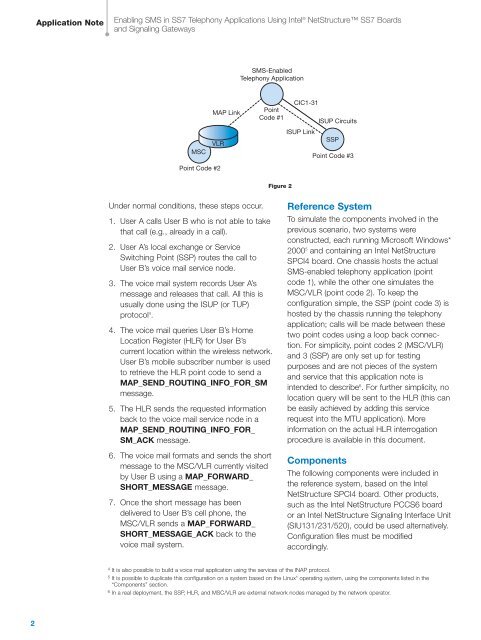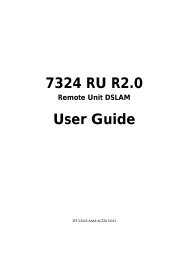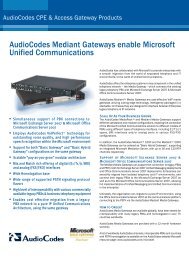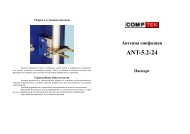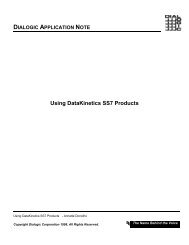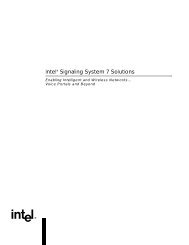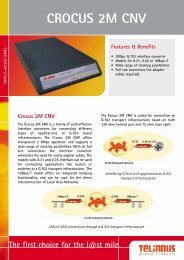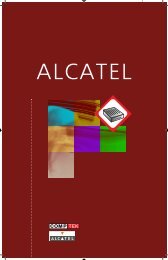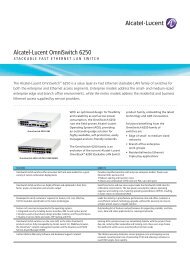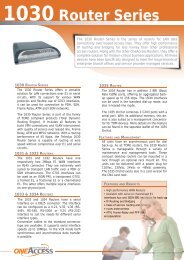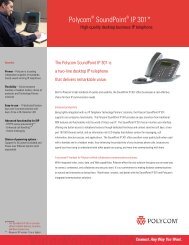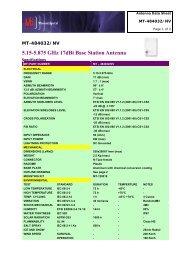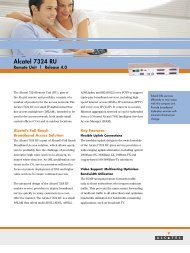Enabling SMS in SS7 Telephony Applications Using ... - CompTek
Enabling SMS in SS7 Telephony Applications Using ... - CompTek
Enabling SMS in SS7 Telephony Applications Using ... - CompTek
Create successful ePaper yourself
Turn your PDF publications into a flip-book with our unique Google optimized e-Paper software.
Application Note<br />
<strong>Enabl<strong>in</strong>g</strong> <strong>SMS</strong> <strong>in</strong> <strong>SS7</strong> <strong>Telephony</strong> <strong>Applications</strong> Us<strong>in</strong>g Intel ® NetStructure <strong>SS7</strong> Boards<br />
and Signal<strong>in</strong>g Gateways<br />
<strong>SMS</strong>-Enabled<br />
<strong>Telephony</strong> Application<br />
MSC<br />
MAP L<strong>in</strong>k<br />
VLR<br />
Po<strong>in</strong>t<br />
Code #1<br />
CIC1-31<br />
ISUP L<strong>in</strong>k<br />
ISUP Circuits<br />
SSP<br />
Po<strong>in</strong>t Code #3<br />
Po<strong>in</strong>t Code #2<br />
Figure 2<br />
Under normal conditions, these steps occur.<br />
1. User A calls User B who is not able to take<br />
that call (e.g., already <strong>in</strong> a call).<br />
2. User A’s local exchange or Service<br />
Switch<strong>in</strong>g Po<strong>in</strong>t (SSP) routes the call to<br />
User B’s voice mail service node.<br />
3. The voice mail system records User A’s<br />
message and releases that call. All this is<br />
usually done us<strong>in</strong>g the ISUP (or TUP)<br />
protocol 4 .<br />
4. The voice mail queries User B’s Home<br />
Location Register (HLR) for User B’s<br />
current location with<strong>in</strong> the wireless network.<br />
User B’s mobile subscriber number is used<br />
to retrieve the HLR po<strong>in</strong>t code to send a<br />
MAP_SEND_ROUTING_INFO_FOR_SM<br />
message.<br />
5. The HLR sends the requested <strong>in</strong>formation<br />
back to the voice mail service node <strong>in</strong> a<br />
MAP_SEND_ROUTING_INFO_FOR_<br />
SM_ACK message.<br />
6. The voice mail formats and sends the short<br />
message to the MSC/VLR currently visited<br />
by User B us<strong>in</strong>g a MAP_FORWARD_<br />
SHORT_MESSAGE message.<br />
7. Once the short message has been<br />
delivered to User B’s cell phone, the<br />
MSC/VLR sends a MAP_FORWARD_<br />
SHORT_MESSAGE_ACK back to the<br />
voice mail system.<br />
Reference System<br />
To simulate the components <strong>in</strong>volved <strong>in</strong> the<br />
previous scenario, two systems were<br />
constructed, each runn<strong>in</strong>g Microsoft W<strong>in</strong>dows*<br />
2000 5 and conta<strong>in</strong><strong>in</strong>g an Intel NetStructure<br />
SPCI4 board. One chassis hosts the actual<br />
<strong>SMS</strong>-enabled telephony application (po<strong>in</strong>t<br />
code 1), while the other one simulates the<br />
MSC/VLR (po<strong>in</strong>t code 2). To keep the<br />
configuration simple, the SSP (po<strong>in</strong>t code 3) is<br />
hosted by the chassis runn<strong>in</strong>g the telephony<br />
application; calls will be made between these<br />
two po<strong>in</strong>t codes us<strong>in</strong>g a loop back connection.<br />
For simplicity, po<strong>in</strong>t codes 2 (MSC/VLR)<br />
and 3 (SSP) are only set up for test<strong>in</strong>g<br />
purposes and are not pieces of the system<br />
and service that this application note is<br />
<strong>in</strong>tended to describe 6 . For further simplicity, no<br />
location query will be sent to the HLR (this can<br />
be easily achieved by add<strong>in</strong>g this service<br />
request <strong>in</strong>to the MTU application). More<br />
<strong>in</strong>formation on the actual HLR <strong>in</strong>terrogation<br />
procedure is available <strong>in</strong> this document.<br />
Components<br />
The follow<strong>in</strong>g components were <strong>in</strong>cluded <strong>in</strong><br />
the reference system, based on the Intel<br />
NetStructure SPCI4 board. Other products,<br />
such as the Intel NetStructure PCCS6 board<br />
or an Intel NetStructure Signal<strong>in</strong>g Interface Unit<br />
(SIU131/231/520), could be used alternatively.<br />
Configuration files must be modified<br />
accord<strong>in</strong>gly.<br />
4 It is also possible to build a voice mail application us<strong>in</strong>g the services of the INAP protocol.<br />
5 It is possible to duplicate this configuration on a system based on the L<strong>in</strong>ux* operat<strong>in</strong>g system, us<strong>in</strong>g the components listed <strong>in</strong> the<br />
“Components” section.<br />
6 In a real deployment, the SSP, HLR, and MSC/VLR are external network nodes managed by the network operator.<br />
2


